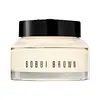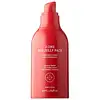What's inside
What's inside
 Key Ingredients
Key Ingredients

 Benefits
Benefits

 Concerns
Concerns

 Ingredients Side-by-side
Ingredients Side-by-side

Water
Skin ConditioningCyclopentasiloxane
EmollientBis-Diglyceryl Polyacyladipate-2
EmollientButylene Glycol
HumectantPPG-2 Myristyl Ether Propionate
EmollientCetyl Alcohol
EmollientPEG-40 Stearate
EmulsifyingButyrospermum Parkii Butter
Skin ConditioningSqualane
EmollientGlyceryl Stearate
EmollientSorbitan Stearate
EmulsifyingEpilobium Angustifolium Extract
Skin ConditioningYeast Extract
Skin ConditioningBeta-Carotene
Skin ConditioningSodium Hyaluronate
HumectantCitrus Grandis Peel Oil
MaskingTocopheryl Acetate
AntioxidantMethyl Glucose Sesquistearate
EmollientPelargonium Graveolens Flower Oil
MaskingDimethicone Crosspolymer
Emulsion StabilisingAcrylates/C10-30 Alkyl Acrylate Crosspolymer
Emulsion StabilisingCarbomer
Emulsion StabilisingPEG-20 Methyl Glucose Sesquistearate
EmulsifyingC12-15 Alkyl Ethylhexanoate
EmollientTetrasodium EDTA
Sodium Hydroxide
BufferingPanthenol
Skin ConditioningMagnesium Ascorbyl Phosphate
AntioxidantLimonene
PerfumingCitronellol
PerfumingGeraniol
PerfumingLinalool
PerfumingChlorphenesin
AntimicrobialPhenoxyethanol
PreservativeWater, Cyclopentasiloxane, Bis-Diglyceryl Polyacyladipate-2, Butylene Glycol, PPG-2 Myristyl Ether Propionate, Cetyl Alcohol, PEG-40 Stearate, Butyrospermum Parkii Butter, Squalane, Glyceryl Stearate, Sorbitan Stearate, Epilobium Angustifolium Extract, Yeast Extract, Beta-Carotene, Sodium Hyaluronate, Citrus Grandis Peel Oil, Tocopheryl Acetate, Methyl Glucose Sesquistearate, Pelargonium Graveolens Flower Oil, Dimethicone Crosspolymer, Acrylates/C10-30 Alkyl Acrylate Crosspolymer, Carbomer, PEG-20 Methyl Glucose Sesquistearate, C12-15 Alkyl Ethylhexanoate, Tetrasodium EDTA, Sodium Hydroxide, Panthenol, Magnesium Ascorbyl Phosphate, Limonene, Citronellol, Geraniol, Linalool, Chlorphenesin, Phenoxyethanol
Water
Skin ConditioningButylene Glycol
HumectantGlycerin
HumectantNiacinamide
SmoothingPEG-150 Distearate
EmulsifyingPolysorbate 80
EmulsifyingPentylene Glycol
Skin ConditioningChondrus Crispus Extract
Skin ConditioningSaccharum Officinarum Extract
MoisturisingSea Water
HumectantEclipta Prostrata Extract
Skin ConditioningHydrolyzed Collagen
EmollientMelia Azadirachta Leaf Extract
Skin ConditioningHibiscus Sabdariffa Flower Extract
Skin ConditioningMoringa Oleifera Seed Oil
EmollientCamellia Japonica Flower Extract
EmollientCarica Papaya Fruit Extract
Skin ConditioningPancratium Maritimum Extract
BleachingHaematococcus Pluvialis Extract
AntioxidantPEG-240/Hdi Copolymer Bis-Decyltetradeceth-20 Ether
StabilisingCaprylyl Glycol
EmollientOctyldodeceth-16
EmulsifyingPEG-60 Hydrogenated Castor Oil
EmulsifyingAminomethyl Propanol
BufferingAdenosine
Skin ConditioningHydrolyzed Hyaluronic Acid
HumectantPropanediol
SolventCaprylic/Capric Triglyceride
MaskingSodium Hyaluronate Crosspolymer
HumectantHydrolyzed Glycosaminoglycans
HumectantDisodium Adenosine Triphosphate
Skin Conditioning1,2-Hexanediol
Skin ConditioningSodium Hyaluronate
HumectantLecithin
EmollientPolyglutamic Acid
Skin ConditioningSaccharide Isomerate
HumectantBenzyl Glycol
SolventAlgin
MaskingCeramide NP
Skin ConditioningCreatine
Skin ConditioningPotassium Laurate
EmulsifyingSodium Hydroxide
BufferingCholesterol
EmollientOleic Acid
EmollientEthylhexylglycerin
Skin ConditioningSodium Ascorbyl Phosphate
AntioxidantAstaxanthin
Skin ConditioningHyaluronic Acid
HumectantRaspberry Ketone
MaskingCyanocobalamin
Skin ConditioningCarbomer
Emulsion StabilisingBHT
AntioxidantDisodium EDTA
Phenoxyethanol
PreservativeParfum
MaskingWater, Butylene Glycol, Glycerin, Niacinamide, PEG-150 Distearate, Polysorbate 80, Pentylene Glycol, Chondrus Crispus Extract, Saccharum Officinarum Extract, Sea Water, Eclipta Prostrata Extract, Hydrolyzed Collagen, Melia Azadirachta Leaf Extract, Hibiscus Sabdariffa Flower Extract, Moringa Oleifera Seed Oil, Camellia Japonica Flower Extract, Carica Papaya Fruit Extract, Pancratium Maritimum Extract, Haematococcus Pluvialis Extract, PEG-240/Hdi Copolymer Bis-Decyltetradeceth-20 Ether, Caprylyl Glycol, Octyldodeceth-16, PEG-60 Hydrogenated Castor Oil, Aminomethyl Propanol, Adenosine, Hydrolyzed Hyaluronic Acid, Propanediol, Caprylic/Capric Triglyceride, Sodium Hyaluronate Crosspolymer, Hydrolyzed Glycosaminoglycans, Disodium Adenosine Triphosphate, 1,2-Hexanediol, Sodium Hyaluronate, Lecithin, Polyglutamic Acid, Saccharide Isomerate, Benzyl Glycol, Algin, Ceramide NP, Creatine, Potassium Laurate, Sodium Hydroxide, Cholesterol, Oleic Acid, Ethylhexylglycerin, Sodium Ascorbyl Phosphate, Astaxanthin, Hyaluronic Acid, Raspberry Ketone, Cyanocobalamin, Carbomer, BHT, Disodium EDTA, Phenoxyethanol, Parfum
 Reviews
Reviews

Ingredients Explained
These ingredients are found in both products.
Ingredients higher up in an ingredient list are typically present in a larger amount.
Butylene Glycol (or BG) is used within cosmetic products for a few different reasons:
Overall, Butylene Glycol is a safe and well-rounded ingredient that works well with other ingredients.
Though this ingredient works well with most skin types, some people with sensitive skin may experience a reaction such as allergic rashes, closed comedones, or itchiness.
Learn more about Butylene GlycolCarbomer is a polymer of acrylic acid. Its main role is to create a gel consistency.
A high amount of carbomer can cause pilling or balling up of products. Don't worry, most products contain 1% or less of carbomer.
Phenoxyethanol is a preservative that has germicide, antimicrobial, and aromatic properties. Studies show that phenoxyethanol can prevent microbial growth. By itself, it has a scent that is similar to that of a rose.
It's often used in formulations along with Caprylyl Glycol to preserve the shelf life of products.
Sodium Hyaluronate is hyaluronic acid's salt form. It is commonly derived from the sodium salt of hyaluronic acid.
Like hyaluronic acid, it is great at holding water and acts as a humectant. This makes it a great skin hydrating ingredient.
Sodium Hyaluronate is naturally occurring in our bodies and is mostly found in eye fluid and joints.
These are some other common types of Hyaluronic Acid:
Learn more about Sodium HyaluronateSodium Hydroxide is also known as lye or caustic soda. It is used to adjust the pH of products; many ingredients require a specific pH to be effective.
In small amounts, sodium hydroxide is considered safe to use. However, large amounts may cause chemical burns due to its high alkaline.
Your skin has a natural pH and acid mantle. This acid mantle helps prevent harmful bacteria from breaking through. The acid mantle also helps keep your skin hydrated.
"Alkaline" refers to a high pH level. A low pH level would be considered acidic.
Learn more about Sodium HydroxideWater. It's the most common cosmetic ingredient of all. You'll usually see it at the top of ingredient lists, meaning that it makes up the largest part of the product.
So why is it so popular? Water most often acts as a solvent - this means that it helps dissolve other ingredients into the formulation.
You'll also recognize water as that liquid we all need to stay alive. If you see this, drink a glass of water. Stay hydrated!
Learn more about Water